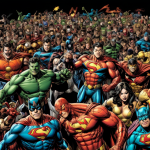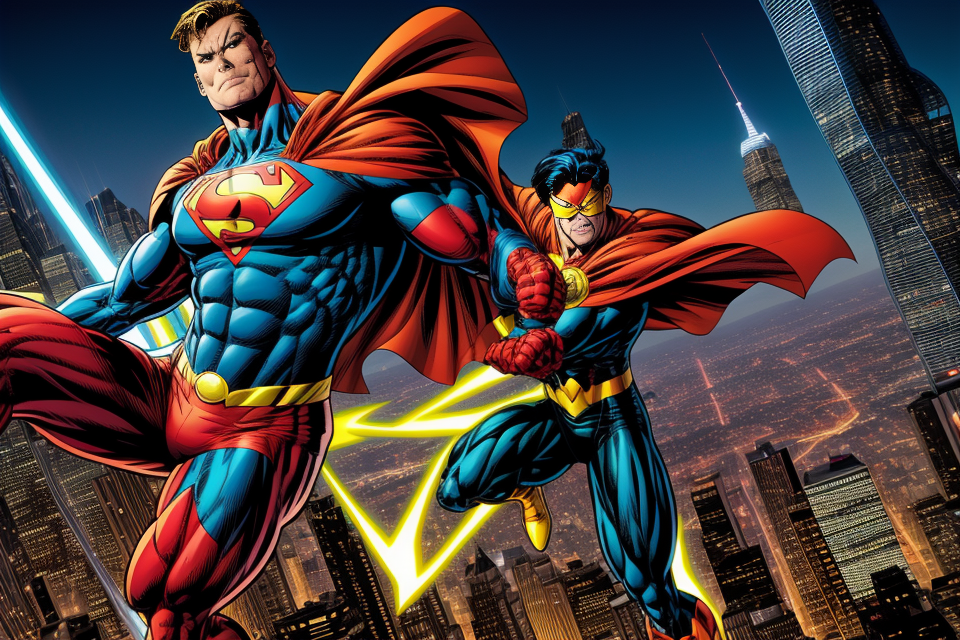The world of superheroes has always been fascinating to us. We grew up reading comic books and watching movies where superheroes saved the world from villains. But little did we know that there are real-life superheroes too. People who have dedicated their lives to helping others and making the world a better place. Among these real-life superheroes, one name stands out above the rest – Malala Yousafzai.
In this article, we will take a comprehensive look at Malala’s life and achievements, and why she is considered the most famous real-life superhero. From her early days in Pakistan to her advocacy for girls’ education, we will explore how Malala has become a symbol of hope and inspiration for millions of people around the world.
We will also delve into her journey after surviving an assassination attempt by the Taliban, and how she has continued to fight for the rights of girls and women. Through her work, Malala has shown us that one person can make a difference, and that we all have the power to be superheroes in our own way.
So join us as we take a closer look at the life and legacy of Malala Yousafzai, the most famous real-life superhero of our time.
Who is the Most Famous Real-Life Superhero?
Origins of the Superhero Concept
The concept of the superhero can be traced back to ancient mythology, where gods and heroes were often depicted as having extraordinary abilities and powers. However, the modern superhero as we know it today began to take shape in the early 20th century, with the publication of pulp fiction novels and comic books.
One of the earliest and most influential superheroes was the character of Doc Savage, who first appeared in a novel in 1933. Doc Savage was a scientist and adventurer who used his incredible intelligence and physical prowess to fight crime and injustice. He was soon followed by other superheroes such as Superman, Batman, and Wonder Woman, who have become some of the most iconic and enduring figures in popular culture.
The rise of the superhero in comic books and other media helped to shape the way that we think about heroism and the role of individuals in society. The superhero represents an idealized version of the human capacity for courage, selflessness, and compassion, and has become a powerful symbol of hope and inspiration for people of all ages.
However, the superhero is not just a fictional concept. In real life, there have been many individuals who have displayed extraordinary bravery and selflessness in the face of danger and adversity. These real-life superheroes, such as first responders, healthcare workers, and activists, embody the same qualities of courage, compassion, and selflessness that we associate with the superhero myth.
The Evolution of Superheroes in Pop Culture
Superheroes have been a staple of pop culture for decades, with characters like Superman, Batman, and Spider-Man capturing the imaginations of generations of fans. But what about real-life superheroes? Who is the most famous of them all?
One could argue that the most famous real-life superhero is a man known as “Batman.” No, not the Caped Crusader from the DC Comics universe, but rather a retired Air Force veteran named Leonardo “Leo” Beckman. Beckman became a viral sensation in 2016 after he donned a homemade Batman suit and began patrolling the streets of New York City.
Beckman’s story is one of perseverance and determination. After serving in the Air Force, he suffered from PTSD and found himself living on the streets. It was during this time that he developed a love for comic books and superheroes, and he began to channel his struggles into creating his own superhero persona.
Using his skills as a seamstress, Beckman fashioned a homemade Batman suit and began patrolling the streets of New York City. He quickly gained attention from the media and fans alike, who were inspired by his dedication to fighting crime and helping those in need.
The Evolution of Superheroes in Pop Culture
Beckman’s story is just one example of how superheroes have evolved in pop culture over the years. From the early days of comic books to the modern-day Marvel Cinematic Universe, superheroes have become a fixture of our cultural landscape.
One of the earliest superheroes was “The Phantom,” a syndicated comic strip that first appeared in 1936. The Phantom was a crime-fighter who wore a skull-shaped ring that gave him superhuman strength and agility. He was also the first superhero to wear a costume, which has since become a staple of the genre.
In the 1960s, superheroes became even more popular with the launch of the “Silver Age” of comics. This era saw the introduction of iconic characters like Spider-Man, The X-Men, and The Avengers. These characters were more relatable than their predecessors, with flaws and personal struggles that readers could identify with.
In recent years, superheroes have become even more ubiquitous, with movies like the Marvel Cinematic Universe and DC Extended Universe dominating the box office. These films have not only brought superheroes to a wider audience, but they have also expanded the genre in new and exciting ways.
Despite their evolution, superheroes remain a constant in our cultural landscape. They inspire us to be better, to fight for what is right, and to never give up. And for many of us, they continue to be a source of comfort and inspiration in a world that can often seem chaotic and unpredictable.
The Impact of Superheroes on Society
Superheroes have become an integral part of popular culture and have had a significant impact on society. They embody the ideals of courage, justice, and selflessness, and have inspired countless individuals to make a positive difference in the world. In this section, we will explore the various ways in which superheroes have influenced society.
The Role of Superheroes in Shaping Cultural Values
Superheroes have played a significant role in shaping cultural values and norms. They have provided a powerful platform for exploring complex social issues, such as race, gender, and class. For example, characters like Wonder Woman and Black Panther have challenged traditional gender roles and represented the strength and leadership of women and people of color. By presenting these characters as heroes, they have helped to change societal attitudes and perceptions towards these groups.
The Influence of Superheroes on Philanthropy and Community Service
Superheroes have also had a profound impact on philanthropy and community service. Many individuals have been inspired by the selflessness and heroism of superheroes to become involved in charitable causes and volunteer work. Superhero-themed charity events and campaigns have become increasingly popular, raising millions of dollars for various causes. Additionally, superhero costumes have been used to bring joy and comfort to children in hospitals and other patients in need.
The Effect of Superheroes on the Entertainment Industry
Superheroes have had a significant impact on the entertainment industry, inspiring countless movies, TV shows, and comic books. They have become a lucrative and influential genre, generating billions of dollars in revenue and attracting audiences of all ages. The success of superhero movies and TV shows has led to the creation of entire franchises and universes, with each character and story adding to the larger cultural conversation.
In conclusion, superheroes have had a profound impact on society, shaping cultural values, inspiring philanthropy and community service, and influencing the entertainment industry. They have become an integral part of our collective consciousness and will continue to inspire and influence future generations.
Real-Life Heroes Throughout History
Throughout history, there have been numerous individuals who have exhibited exceptional bravery and selflessness in the face of danger or adversity. These real-life heroes have inspired and influenced countless people with their acts of courage and compassion. Some of the most well-known real-life heroes include:
- Joan of Arc: A French peasant girl who led the French army to victory during the Hundred Years’ War. She was later captured and executed by the English, but her bravery and selflessness have made her a symbol of French nationalism.
- Mahatma Gandhi: An Indian political leader who used nonviolent resistance to lead India to independence from British rule. He was a advocate for civil rights and social justice, and his legacy continues to inspire people around the world.
- Rosa Parks: An American civil rights activist who refused to give up her seat on a bus to a white person, sparking the Montgomery Bus Boycott and helping to bring about the end of segregation in the United States.
- Malala Yousafzai: A Pakistani activist for girls’ education and the youngest Nobel Prize laureate. She survived an assassination attempt by the Taliban and has continued to speak out for the rights of women and girls around the world.
- Brian Williams: An American news anchor who is known for his bravery and heroism in covering major events such as the Gulf War and Hurricane Katrina.
- Chesley Sullenberger: An American pilot who successfully landed a passenger plane on the Hudson River in New York City after both engines failed, saving the lives of all 155 passengers and crew on board.
These real-life heroes have made a significant impact on the world and continue to inspire others to stand up for what they believe in and make a difference in the lives of others.
The Rise of Modern-Day Superheroes
In recent years, the concept of modern-day superheroes has gained immense popularity. These individuals, often ordinary citizens, have taken it upon themselves to fight crime, protect the innocent, and uphold justice in their communities. The rise of modern-day superheroes can be attributed to several factors, including:
- Increased awareness and media coverage: With the proliferation of social media and 24-hour news cycles, stories of heroic acts and selflessness are more accessible than ever before. This increased exposure has inspired countless individuals to take up the mantle of superheroism in their own lives.
- The need for positive role models: In a world where corruption and negativity seem to permeate every aspect of society, many people are seeking positive role models to look up to. Modern-day superheroes provide an inspiring example of selflessness, bravery, and determination, and their actions can serve as a catalyst for change in the lives of others.
- The growth of the comic book industry: The comic book industry has exploded in recent years, with blockbuster movies and TV shows bringing superheroes to the forefront of popular culture. This increased exposure has fueled a desire in many people to emulate their favorite heroes and make a difference in their own communities.
- The desire for personal fulfillment: For many modern-day superheroes, their actions are driven by a deep sense of personal fulfillment and a desire to make a positive impact on the world. By taking action and standing up for what they believe in, these individuals are able to find a sense of purpose and meaning in their lives.
Overall, the rise of modern-day superheroes is a testament to the inherent goodness and compassion of humanity. As more and more individuals step forward to make a difference in their communities, the world becomes a better place for all of us.
The Influence of Comics and Movies on Real-Life Heroes
The portrayal of superheroes in comics and movies has had a significant impact on real-life heroes. These fictional characters have inspired people to take action and make a difference in their communities. In many cases, real-life heroes have adopted the personas and costumes of their favorite superheroes as a way to embody the values and ideals of these characters.
One of the most well-known examples of this phenomenon is the group of crime fighters known as the “Night Hawk Squadron.” This group of volunteers patrolled the streets of Rio de Janeiro, Brazil, in the 1980s and 1990s, fighting crime and drug trafficking. The members of the Night Hawk Squadron were inspired by the comic book character of the same name and adopted his costume and weaponry.
Another example is the “Avengers of London,” a group of volunteers who patrolled the streets of London during World War II. These men and women were inspired by the comic book characters of the same name and wore costumes that were modeled after the superheroes they admired.
The influence of comics and movies on real-life heroes is not limited to crime-fighting. Many people have been inspired by the heroic ideals of superheroes to become activists, volunteers, and community leaders. The example of these fictional characters has encouraged people to take action and make a positive impact in the world.
Overall, the influence of comics and movies on real-life heroes is a testament to the power of storytelling and the enduring appeal of the superhero archetype. These fictional characters have inspired people to be heroes in their own lives and communities, and their legacy continues to inspire new generations of heroes.
The Psychology Behind Superheroes
The Allure of Superheroes
Superheroes have been a part of our culture for decades, captivating audiences with their extraordinary abilities and unwavering commitment to justice. But what is it about superheroes that makes them so alluring?
One reason is their embodiment of the idealized self. Superheroes often possess qualities that we admire but struggle to attain in our own lives, such as strength, courage, and selflessness. By identifying with these characters, we can vicariously experience the sense of purpose and fulfillment that comes with embodying these qualities.
Another reason is the escapist appeal of superhero stories. In a world that can often be chaotic and unpredictable, superheroes provide a sense of order and stability. By imagining ourselves as superheroes, we can temporarily escape from the challenges of our own lives and enter a world where good always triumphs over evil.
Finally, superheroes also represent a form of wish fulfillment. We may not have the ability to save the world from supervillains, but through our favorite superheroes, we can imagine ourselves doing just that. This allows us to experience a sense of power and control in a world where we often feel powerless.
Overall, the allure of superheroes is multifaceted and complex. They offer us a way to explore our own desires and aspirations, while also providing a sense of comfort and escape from the realities of our daily lives.
The Psychological Benefits of Superhero Stories
Superhero stories have been a part of human culture for centuries, and their popularity has only increased in recent years. The psychological benefits of superhero stories are numerous and varied, making them a valuable tool for promoting mental health and well-being.
One of the most significant psychological benefits of superhero stories is their ability to provide a sense of empowerment. By following the journeys of superheroes, readers and viewers can see how even the most seemingly ordinary individuals can achieve extraordinary feats and make a positive impact on the world. This sense of empowerment can help to boost self-esteem and promote a feeling of control over one’s own life.
Another benefit of superhero stories is their ability to help viewers and readers process and cope with difficult emotions. Superheroes often face incredible challenges and adversity, and their stories can provide a framework for viewers to understand and work through their own struggles. For example, the loss of a loved one or a difficult breakup may be easier to cope with when viewed through the lens of a superhero’s journey.
Superhero stories also have the power to inspire altruism and empathy. Many superheroes are driven by a desire to help others and make the world a better place. This focus on selflessness and compassion can inspire viewers to adopt these values in their own lives, leading to a greater sense of connection to others and a stronger sense of community.
Additionally, superhero stories can help to promote a sense of hope and optimism. Even in the darkest of times, superheroes often find a way to save the day and make the world a better place. This sense of hope can be especially important in times of crisis or uncertainty, as it can provide a beacon of light in a sea of darkness.
Overall, the psychological benefits of superhero stories are numerous and far-reaching. Whether promoting empowerment, providing a framework for coping with difficult emotions, inspiring altruism and empathy, or promoting a sense of hope and optimism, superhero stories have the power to make a positive impact on the lives of viewers and readers.
The Dark Side of Superhero Obsession
Superhero obsession can have a dark side, as it can lead to a fixation on an unattainable ideal. This can lead to feelings of inadequacy and low self-esteem, as individuals compare themselves to the fictional characters they admire.
Furthermore, superhero obsession can also manifest in dangerous ways, such as violence or criminal behavior. This can be seen in cases where individuals dress up as superheroes and engage in reckless behavior, or in cases where individuals become so obsessed with a particular superhero that they begin to emulate their actions in dangerous ways.
Additionally, superhero obsession can also have negative effects on relationships and social interactions. Individuals who are heavily invested in superhero culture may struggle to connect with others who do not share their interests, leading to isolation and loneliness.
Overall, while superhero obsession can be a fun and harmless interest for many, it is important to be aware of the potential negative effects it can have on mental health and social relationships.
The Most Famous Real-Life Superheroes
Superman: The Man of Steel
Superman, the first and most famous superhero in the world, has been captivating audiences for over 80 years. Created by Jerry Siegel and Joe Shuster, Superman’s origin story began in 1938 when they introduced the character in Action Comics #1.
The character quickly became a pop culture icon, known for his incredible strength, speed, and the ability to fly. Superman’s superpowers are derived from his alien origin, as he was born on the planet Krypton and rocketed to Earth as an infant. His powers include super strength, speed, invulnerability, and heat vision, among others.
Superman’s iconic suit consists of a blue costume with a red cape and a crest on his chest. He also wears a pair of red boots, blue tights, and a red “S” symbol on his chest. This suit is designed to be functional, allowing Superman to move freely and providing him with the ability to see through walls.
Superman’s story is not just about his superpowers, but also his moral compass. He is a symbol of truth, justice, and the American way. He fights for what is right, standing up against evil and injustice. His character has been a source of inspiration for generations, representing the ultimate hero that people aspire to be.
Superman has been portrayed in numerous films, TV shows, and comic books, making him one of the most recognizable characters in popular culture. His impact on the world of entertainment and beyond cannot be overstated. Superman has inspired countless people to be heroes in their own lives, and his legacy continues to live on.
Batman: The Dark Knight
Batman, also known as the Dark Knight, is one of the most well-known and beloved superheroes in the world. Created by Bob Kane and Bill Finger, Batman first appeared in Detective Comics #27 in 1939.
Over the years, Batman has become a cultural icon, known for his distinctive black and gray costume, his incredible detective skills, and his unwavering commitment to justice. He is a master martial artist, an expert strategist, and a brilliant detective, using his intellect and his vast array of gadgets to fight crime and protect the citizens of Gotham City.
One of the most intriguing aspects of Batman’s character is his tragic backstory. The death of his parents at a young age transformed Bruce Wayne into a grim avenger, determined to rid Gotham of criminals and make the city a safer place. His personal fortune and his genius intellect allow him to pursue his mission in a unique way, making him one of the most powerful and effective superheroes in the DC Universe.
Batman’s popularity has transcended the pages of comic books and has become a major part of popular culture. He has appeared in numerous films, television shows, and video games, and his influence can be seen in many other forms of media.
The Dark Knight’s appeal is not limited to the United States; he is beloved around the world, with fans in every corner of the globe. His iconic status has made him a symbol of hope and justice, inspiring generations of fans to believe that anyone can make a difference and fight for what is right.
In addition to his superheroic abilities, Batman is also known for his relationships with other superheroes and villains. He is a founding member of the Justice League, and has worked closely with other heroes such as Superman, Wonder Woman, and the Flash. He has also battled some of the most infamous villains in the DC Universe, including the Joker, Penguin, and Riddler.
Overall, Batman is a complex and multifaceted character who has captured the imaginations of millions of fans around the world. His enduring popularity is a testament to the power of the superhero genre, and his legacy will continue to inspire generations to come.
Spider-Man: The Web-Slinger
Peter Parker, also known as Spider-Man, is one of the most well-known superheroes in the world. He first appeared in the comic book “Amazing Fantasy” #15 in 1962, and has since become an iconic figure in popular culture.
Spider-Man’s powers include superhuman strength, speed, and agility, as well as the ability to climb walls and shoot webs from his wrists. He also has a heightened sense of intuition and the ability to “crawl” on surfaces.
One of the most distinctive aspects of Spider-Man’s character is his sense of responsibility. He often struggles with the weight of his powers and the consequences of his actions, but ultimately always does his best to use his abilities for the greater good.
Spider-Man’s origin story is one of the most well-known in comic book history. He was bitten by a radioactive spider, which gave him his powers. He then went on to use his abilities to fight crime and protect the people of New York City.
In addition to his comic book appearances, Spider-Man has also been featured in a number of movies and television shows, including the popular animated series “Spider-Man: The Animated Series” and the live-action films “Spider-Man” (2002) and “Spider-Man: Homecoming” (2017).
Despite his popularity, Spider-Man’s identity is still a closely guarded secret. His true identity is known only to a few trusted individuals, and he has taken great pains to keep his personal life separate from his superhero life.
Overall, Spider-Man is a beloved and enduring figure in popular culture, and his story continues to inspire and captivate audiences around the world.
Wonder Woman: The Amazon Princess
Wonder Woman, also known as Diana Prince, is one of the most famous real-life superheroes. She was created by William Moulton Marston and first appeared in All Star Comics #8 in 1941.
Origin Story
Wonder Woman’s origin story is rooted in Greek mythology. She is the daughter of Queen Hippolyta, the Amazon queen, and Zeus, the king of the gods. According to legend, the Amazons were a tribe of warrior women who lived on the island of Themyscira, isolated from the outside world. One day, the Amazon princess Diana was sent to the outside world to help end a conflict between two nations.
Powers and Abilities
Wonder Woman’s powers and abilities are a result of her Amazonian heritage and her connection to the gods. She possesses superhuman strength, speed, and agility, as well as the ability to fly. She also has a “Lasso of Truth,” which compels those bound by it to tell the truth. Additionally, she has a tiara that can deflect bullets and other projectiles.
Costume and Accessories
Wonder Woman’s costume is iconic and has undergone several changes over the years. The classic costume consists of a red, white, and blue top with a gold eagle emblem on the chest, a red skirt, and silver bracelets. She also wears a tiara, which is often depicted as a crown. Her accessories include the Lasso of Truth and her bulletproof bracelets.
Significance and Impact
Wonder Woman has been a significant and influential figure in popular culture for decades. She has appeared in various media, including comic books, television shows, and movies. Her story has resonated with many people, particularly women, who have found inspiration in her strength, courage, and determination. Wonder Woman has also been an important representation of female empowerment and has helped to challenge traditional gender roles and expectations.
Iron Man: The Tech Genius
Tony Stark, the alter ego of Iron Man, is one of the most well-known superheroes in the Marvel Cinematic Universe. But did you know that there are real-life people who have made significant contributions to technology and innovation, just like Iron Man? In this section, we will explore some of the most famous real-life tech geniuses who have made a difference in the world.
Elon Musk
Elon Musk is a South African-born American entrepreneur, engineer, and inventor. He is best known for his work in the tech industry, including co-founding PayPal, Tesla, SpaceX, and Neuralink. Musk’s innovations have revolutionized the electric car industry, made space travel more accessible, and even inspired Iron Man’s suit technology. He is often referred to as the real-life Iron Man and has been praised for his forward-thinking ideas and determination to make the world a better place.
Steve Jobs
Steve Jobs was an American entrepreneur and businessman who co-founded Apple Inc. He is widely regarded as one of the most influential and innovative thinkers of the 20th century. Jobs was known for his vision and passion for technology, which led to the creation of iconic products such as the Macintosh computer, the iPod, and the iPhone. His contributions to the tech industry have changed the way we live and work, and his legacy continues to inspire innovators and entrepreneurs around the world.
Bill Gates
Bill Gates is an American entrepreneur, philanthropist, and co-founder of Microsoft Corporation. He is one of the richest people in the world and has donated billions of dollars to charitable causes through the Bill and Melinda Gates Foundation. Gates is also a respected voice in the tech industry and has been instrumental in shaping the development of personal computing, software, and the internet. His contributions to technology have made a significant impact on the world and have changed the way we live, work, and communicate.
These are just a few examples of the many real-life tech geniuses who have made a difference in the world. From inventors and entrepreneurs to scientists and engineers, these individuals have pushed the boundaries of what is possible and have inspired generations of innovators and thinkers.
Black Widow: The Assassin
Early Life and Training
Black Widow, whose real name is Natalia Alianovna Romanova, was born in Soviet Russia in 1920. Orphaned at a young age, she was recruited by the KGB and underwent extensive training in various forms of combat, espionage, and assassination.
Service in the Soviet Union
Black Widow served as a deadly agent for the Soviet Union during the Cold War, performing various covert operations and eliminating enemies of the state. Her ruthless efficiency and effectiveness earned her a reputation as one of the most feared and skilled assassins in the world.
Betrayal and Exile
However, Black Widow’s loyalty to the Soviet Union was eventually called into question, and she was forced to flee the country to avoid punishment. She resurfaced in the United States, where she worked as a freelance agent, taking on high-stakes missions for various clients.
Joining the Avengers
Black Widow eventually joined the Avengers, a team of powerful superheroes, where she used her skills and expertise to fight against threats to the world. Despite her violent past, she proved to be a valuable member of the team, using her intelligence and cunning to outmaneuver enemies and protect innocent lives.
Black Widow’s abilities include a mastery of various martial arts and weapons, as well as the use of a unique venom that she can deliver through her weapons or bare hands. She is also highly intelligent and resourceful, able to think on her feet and adapt to changing situations.
Legacy
Black Widow’s legacy as a real-life superhero is one of intrigue and danger. Her story serves as a reminder of the complex and often morally ambiguous world of espionage and assassination, and the lengths to which some individuals will go to achieve their goals.
The Real-Life Heroes Behind the Masks
The Inspiring Stories of Everyday Heroes
When it comes to real-life superheroes, we often think of people who have achieved extraordinary feats, performed selfless acts, or fought against injustice. However, the everyday heroes are often overlooked. These are the individuals who may not have the fame or recognition of larger-than-life superheroes, but their impact on their communities and the lives of those around them is no less significant.
- First Responders: These are the people who put their lives on the line to protect and serve the public. From police officers to firefighters, EMTs, and paramedics, they risk their own safety to help others in times of crisis. They are often the first to arrive on the scene of an emergency and are trained to handle dangerous situations with bravery and compassion.
- Medical Professionals: The men and women who work in hospitals, clinics, and other medical facilities are true heroes. They dedicate their lives to caring for the sick and injured, often working long hours under difficult conditions. They use their knowledge and skills to save lives, ease pain, and provide comfort to those in need.
- Teachers: Educators are essential to the development of future generations. They work tirelessly to inspire and educate their students, often going above and beyond to ensure that their students receive the best education possible. They are mentors, counselors, and role models, shaping the minds and hearts of young people.
- Community Leaders: These are the individuals who lead by example, working to make their communities better places to live. They may be involved in local politics, volunteer organizations, or faith-based groups, and they use their influence to effect positive change. They are tireless advocates for their causes, and their passion and dedication inspire others to get involved and make a difference.
- Neighbors: Finally, we must not forget the everyday heroes who live next door. These are the people who look out for their neighbors, lend a helping hand, and provide support when it is needed. They may not always receive recognition for their actions, but their kindness and generosity have a profound impact on the lives of those around them.
In conclusion, the everyday heroes among us are often unsung, but their impact on our lives and communities is no less significant than that of larger-than-life superheroes. Whether it is through their bravery, compassion, knowledge, or dedication, these individuals inspire us to be better, to do more, and to make a positive difference in the world.
The Importance of Real-Life Heroes in Our Lives
In a world where it seems like every day brings a new challenge, it’s important to have role models that we can look up to. People who embody the qualities that we aspire to, such as bravery, selflessness, and a commitment to making the world a better place. That’s why real-life heroes are so important in our lives.
Here are just a few reasons why real-life heroes matter:
- They inspire us to be better people
- They give us hope in difficult times
- They remind us that there is still good in the world
- They provide an example of what can be achieved through hard work and determination
These are just a few of the many reasons why real-life heroes are so important in our lives. They serve as a shining example of what it means to be a hero, and they remind us that even in the darkest of times, there is always hope.
The Role of Real-Life Heroes in Society
In today’s world, real-life heroes play a vital role in society. They are individuals who put their lives on the line to protect and serve others, often going above and beyond the call of duty. These heroes come from all walks of life, and their stories are inspiring and motivating to many.
First Responders
First responders, such as police officers, firefighters, and paramedics, are often considered real-life heroes. They risk their lives every day to protect and serve their communities, responding to emergencies and dangerous situations. Their bravery and selflessness are exemplary, and they are deeply respected by the public.
Medical Professionals
Medical professionals, including doctors, nurses, and healthcare workers, are also real-life heroes. They work tirelessly to care for the sick and injured, often in challenging and stressful environments. Their dedication and compassion are essential in helping people overcome illness and injury, and they are deeply appreciated by those they serve.
Military Personnel
Military personnel, including soldiers, sailors, airmen, and marines, are also real-life heroes. They risk their lives to protect their countries and defend their fellow citizens. Their sacrifices and bravery are commendable, and they are deeply respected by the public.
Volunteers
Volunteers, including those who work with non-profit organizations, charities, and community groups, are also real-life heroes. They give their time and energy to help others, often without expectation of reward or recognition. Their selflessness and dedication are inspiring, and they are deeply appreciated by the communities they serve.
In conclusion, real-life heroes play a vital role in society, and their contributions are invaluable. They are individuals who put their lives on the line to protect and serve others, and their stories are inspiring and motivating to many.
The Future of Superheroes
The Evolution of Superhero Stories
Superhero stories have come a long way since their inception in the early 20th century. Over the years, they have evolved and adapted to changing societal norms, cultural shifts, and technological advancements. In this section, we will take a closer look at the evolution of superhero stories and how they have changed over time.
The Golden Age of Comics (1938-1950)
The Golden Age of Comics marked the beginning of the superhero genre. It was during this time that characters like Superman, Batman, and Wonder Woman were introduced. These characters were created in response to the Great Depression and the rise of fascism in Europe. They represented the ideal of heroism and were seen as symbols of hope and inspiration.
The Silver Age of Comics (1956-1970)
The Silver Age of Comics saw the revival of the superhero genre after a decline in popularity in the 1940s and 1950s. This period saw the introduction of new characters like Spider-Man, the X-Men, and the Fantastic Four. The stories became more complex and featured science fiction and fantasy elements. The Silver Age also saw the introduction of the concept of the “universe” where all the superheroes existed in the same world.
The Bronze Age of Comics (1970-1985)
The Bronze Age of Comics saw a shift towards darker and more mature storytelling. This period was marked by the introduction of anti-heroes like Batman and the Punisher. The stories became more realistic and tackled social issues like drug abuse, racism, and political corruption. The Bronze Age also saw the rise of female superheroes like Wonder Woman and the introduction of new characters like Swamp Thing and The Teen Titans.
The Modern Age of Comics (1985-Present)
The Modern Age of Comics saw a return to the classic superhero formula, but with a modern twist. This period saw the introduction of characters like Watchmen, The Dark Knight Returns, and The Sandman. The stories became more complex and tackled mature themes like politics, religion, and sexuality. The Modern Age also saw the rise of independent comics and graphic novels.
In conclusion, the evolution of superhero stories has been shaped by various cultural, social, and political factors. From the Golden Age to the Modern Age, superheroes have evolved to reflect the changing times and continue to inspire and captivate audiences around the world.
The Impact of Technology on Superheroes
The Role of Technology in the Evolution of Superheroes
As technology continues to advance at an exponential rate, it has begun to play a significant role in the evolution of superheroes. The use of technology has allowed superheroes to develop new abilities and enhance their existing ones, enabling them to fight crime and protect the public in ways that were once thought impossible.
The Emergence of High-Tech Superheroes
One of the most significant impacts of technology on superheroes is the emergence of high-tech superheroes. These superheroes rely heavily on technology to fight crime and protect the public. They use advanced weapons, gadgets, and vehicles to gain an edge in battle, and their abilities are often directly tied to the technology they use.
The Role of Artificial Intelligence in Superheroism
Artificial intelligence (AI) is another area where technology has had a significant impact on superheroes. Many superheroes now rely on AI to help them make decisions, analyze data, and even control their technology. This has allowed superheroes to become more efficient and effective in their fight against crime.
The Ethical Implications of High-Tech Superheroes
While technology has greatly enhanced the abilities of superheroes, it has also raised ethical concerns. The use of high-tech weapons and gadgets raises questions about the responsibility of superheroes to use their powers in a responsible manner. Additionally, the reliance on AI raises concerns about the role of technology in decision-making and the potential for bias and discrimination.
The Future of High-Tech Superheroes
As technology continues to advance, it is likely that high-tech superheroes will become even more prevalent. However, it is important for superheroes to consider the ethical implications of their actions and ensure that they are using their powers in a responsible manner. The future of superheroes will depend on their ability to navigate these ethical challenges and use technology in a way that benefits society as a whole.
The Continued Relevance of Superheroes in Pop Culture
- The Enduring Appeal of Superheroes
- The human fascination with heroism and the desire for heroic figures has persisted throughout history, manifesting in various mythologies and folklore.
- Superheroes, as modern-day mythological figures, satisfy this innate need for heroism and provide a source of inspiration and aspiration.
- The Impact of Superheroes on Pop Culture
- Superheroes have become an integral part of pop culture, with their influence spanning across various mediums such as comics, movies, television shows, and video games.
- The popularity of superheroes has transcended borders, fostering a global phenomenon that cuts across cultures and generations.
- The Role of Superheroes in Contemporary Society
- Superheroes serve as reflections of societal values and beliefs, embodying ideals such as justice, truth, and the greater good.
- They provide a platform for discussing and exploring social issues, allowing for meaningful conversations and promoting critical thinking.
- The Adaptability of Superheroes
- The versatility of superheroes allows them to evolve and adapt to changing times, reflecting the contemporary concerns and values of society.
- This adaptability ensures their continued relevance and significance in pop culture, making them an enduring and dynamic aspect of modern society.
The Potential for Real-Life Superheroes in the Future
The potential for real-life superheroes in the future is vast and varied. As society continues to evolve and face new challenges, the need for individuals with extraordinary abilities and a strong sense of justice will only continue to grow.
The Evolution of Superheroes
Superheroes have come a long way since their inception in the 1930s. From the classic caped crusaders of the Golden Age to the complex, flawed heroes of today, the superhero archetype has evolved to reflect the changing values and concerns of society. As technology advances and the world becomes more interconnected, it is likely that superheroes will continue to evolve and adapt to meet the needs of a changing world.
The Importance of Superheroes in Society
Superheroes have always served as a reflection of society’s hopes and fears. In times of crisis, they offer a symbol of hope and inspiration, reminding us that even in the darkest of times, there are those who will stand up for what is right. In times of prosperity, they serve as a reminder of the importance of responsibility and the need to use our powers for good. As the world faces new challenges, from climate change to technological disruption, the role of superheroes in society will only become more important.
The Rise of Real-Life Superheroes
While superheroes have traditionally been the stuff of comic books and movies, in recent years, a new phenomenon has emerged: real-life superheroes. These individuals, often referred to as “superheroes in training,” have taken it upon themselves to fight crime, protect the vulnerable, and promote justice in their communities. While some may view them as eccentric or even dangerous, others see them as a shining example of citizen activism and community service.
The Future of Real-Life Superheroes
As the world continues to change, the potential for real-life superheroes to make a positive impact will only continue to grow. Whether through formal programs like community service or through grassroots efforts, these individuals have the potential to be agents of change in their communities. However, it is important to note that the line between vigilantism and criminal activity can be a fine one, and real-life superheroes must be careful to work within the bounds of the law in order to truly make a positive impact.
Overall, the potential for real-life superheroes in the future is vast and varied. As society continues to evolve and face new challenges, the need for individuals with extraordinary abilities and a strong sense of justice will only continue to grow. Whether through formal programs or grassroots efforts, real-life superheroes have the potential to be agents of change in their communities, inspiring hope and promoting justice in a world that often seems overwhelmed by darkness.
The Importance of Embodying Superhero Values in Real Life
Embodying superhero values in real life is essential for fostering positive change in society. Here are some reasons why:
- Inspiring hope and courage: Superheroes embody the ideals of hope and courage, and by embodying these values in real life, individuals can inspire others to be more hopeful and courageous in their own lives.
- Promoting justice and equality: Superheroes fight for justice and equality, and by embodying these values in real life, individuals can help promote a more just and equal society.
- Encouraging selflessness and altruism: Superheroes often put the needs of others before their own, and by embodying this value in real life, individuals can encourage selflessness and altruism in their communities.
- Promoting positive change: Superheroes are often champions of positive change, and by embodying this value in real life, individuals can help create a more positive and optimistic future for themselves and their communities.
In conclusion, embodying superhero values in real life is essential for fostering positive change in society. By inspiring hope and courage, promoting justice and equality, encouraging selflessness and altruism, and promoting positive change, individuals can make a difference in their communities and create a brighter future for all.
The Responsibility of Superheroes to Make a Positive Impact on the World
The role of superheroes in society has evolved over time, from being mere fictional characters to becoming real-life heroes who make a positive impact on the world. As superheroes continue to gain popularity, it is essential to examine their responsibility to use their powers for the greater good.
Superheroes have a unique position in society, as they possess extraordinary abilities that can be used to help others. However, with great power comes great responsibility, and superheroes must be mindful of the impact their actions have on the world. They must ensure that their actions are ethical and do not cause harm to others.
One of the primary responsibilities of superheroes is to protect the innocent and fight against injustice. They must use their powers to help those who are vulnerable and ensure that justice is served. Superheroes must also work to promote peace and understanding between different groups, as their actions can have a significant impact on society.
Another responsibility of superheroes is to inspire others to make a positive impact on the world. By using their powers for good, superheroes can inspire others to do the same. They can also use their platforms to raise awareness about important social issues and encourage others to take action.
In addition to their responsibilities to society, superheroes must also be mindful of their personal lives. They must balance their heroic duties with their personal relationships and take care of their physical and mental health. This can be challenging, as the demands of being a superhero can be overwhelming.
Overall, the responsibility of superheroes to make a positive impact on the world is a significant one. They must use their powers wisely and ethically, promote peace and understanding, inspire others to make a difference, and balance their heroic duties with their personal lives. By doing so, they can continue to make a positive impact on society and inspire others to do the same.
FAQs
1. Who is the most famous real-life superhero?
There are many real-life heroes who have made significant contributions to society, but one of the most famous real-life superheroes is probably Mother Teresa. She was a Roman Catholic nun who dedicated her life to serving the poor and sick in India and other countries. She founded the Missionaries of Charity, which now has over 5,000 sisters worldwide, and received numerous awards and honors for her selfless work.
2. What made Mother Teresa a real-life superhero?
Mother Teresa was a real-life superhero because of her unwavering commitment to helping others, regardless of their background or circumstances. She worked tirelessly to provide care and support to the poor, sick, and marginalized, and her compassion and kindness inspired countless people around the world. She also founded the Nobel Peace Prize-winning organization, the Elders, which aims to promote peace and human rights globally.
3. Were there any other real-life superheroes besides Mother Teresa?
Yes, there have been many other real-life superheroes throughout history. For example, Mahatma Gandhi was a political and spiritual leader who used nonviolent resistance to challenge British rule in India and advocate for Indian independence. He inspired millions of people to stand up for their rights and is widely regarded as one of the most influential figures of the 20th century.
4. What are some other examples of real-life superheroes?
There are many other examples of real-life superheroes, including activists, volunteers, and everyday people who have made a difference in their communities. Some examples include Malala Yousafzai, who advocates for girls’ education and has survived an assassination attempt by the Taliban; Greta Thunberg, who has inspired a global movement to address climate change; and healthcare workers and first responders who have risked their lives to help others during the COVID-19 pandemic.
5. Why are real-life superheroes important?
Real-life superheroes are important because they inspire us to be better people and work towards a better world. They show us that one person can make a difference, and that even small acts of kindness and compassion can have a ripple effect that transforms communities and societies. They also remind us that there is hope in the face of adversity, and that we can overcome even the most daunting challenges if we work together and stay committed to our goals.









